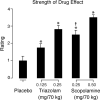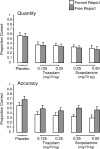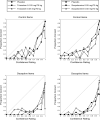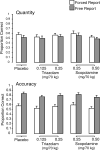Dose effects of triazolam and scopolamine on metamemory
- PMID: 20158291
- PMCID: PMC2846306
- DOI: 10.1037/a0018061
Dose effects of triazolam and scopolamine on metamemory
Abstract
The present study compared the acute dose effects of the benzodiazepine triazolam and the anticholinergic scopolamine on metamemory (knowledge and awareness of one's own memory) in a two-phase paradigm designed to assess effects on both monitoring and control components of metamemory in both semantic (general knowledge) and episodic memory (cued-recall) tasks. Placebo and 2 doses each of triazolam (0.125, 0.25 mg/70 kg, oral) and scopolamine (0.25, 0.50 mg/70 kg, subcutaneous) were administered to 80 healthy volunteers (16 per group) in a double-blind, double-dummy, independent groups design. Both triazolam and scopolamine impaired episodic memory (quantity and accuracy) but not semantic memory. Results suggested that both drugs impaired monitoring as reflected in absolute accuracy measures (impaired calibration in the direction of overconfidence) and control sensitivity (the relationship between confidence and behavior). Overall, the results did not provide evidence for differences between triazolam and scopolamine in memory or metamemory. In addition to the clinical relevance of the observed effects, this study adds to the accumulating body of cognitive psychopharmacological research illustrating the usefulness of drug-induced amnesia as a vehicle to explore memory and metamemory.
(PsycINFO Database Record (c) 2010 APA, all rights reserved).
Figures





Similar articles
-
Drugs, memory, and metamemory: a dose-effect study with lorazepam and scopolamine.Exp Clin Psychopharmacol. 2005 Nov;13(4):336-47. doi: 10.1037/1064-1297.13.4.336. Exp Clin Psychopharmacol. 2005. PMID: 16366764 Clinical Trial.
-
Triazolam-amphetamine interaction: dissociation of effects on memory versus arousal.J Psychopharmacol. 2003 Mar;17(1):17-29. doi: 10.1177/0269881103017001689. J Psychopharmacol. 2003. PMID: 12680736 Clinical Trial.
-
Dose effects of triazolam and alcohol on cognitive performance in healthy volunteers.Exp Clin Psychopharmacol. 2010 Feb;18(1):1-16. doi: 10.1037/a0018407. Exp Clin Psychopharmacol. 2010. PMID: 20158290 Free PMC article. Clinical Trial.
-
Cognitive, psychomotor, and subjective effects of sodium oxybate and triazolam in healthy volunteers.Psychopharmacology (Berl). 2009 Sep;206(1):141-54. doi: 10.1007/s00213-009-1589-1. Epub 2009 Jun 20. Psychopharmacology (Berl). 2009. PMID: 19543883 Free PMC article.
-
Acute dose-effects of scopolamine on false recognition.Psychopharmacology (Berl). 2001 Feb;153(4):425-33. doi: 10.1007/s002130000592. Psychopharmacology (Berl). 2001. PMID: 11243489 Clinical Trial.
Cited by
-
Cholinergic receptor subtypes and their role in cognition, emotion, and vigilance control: an overview of preclinical and clinical findings.Psychopharmacology (Berl). 2011 May;215(2):205-29. doi: 10.1007/s00213-010-2153-8. Epub 2011 Jan 8. Psychopharmacology (Berl). 2011. PMID: 21212938 Review.
-
Differential Neural Correlates Underlie Judgment of Learning and Subsequent Memory Performance.Front Psychol. 2015 Nov 9;6:1699. doi: 10.3389/fpsyg.2015.01699. eCollection 2015. Front Psychol. 2015. PMID: 26617540 Free PMC article.
-
Cognitive effects of intramuscular ketamine and oral triazolam in healthy volunteers.Psychopharmacology (Berl). 2013 Mar;226(1):53-63. doi: 10.1007/s00213-012-2883-x. Epub 2012 Oct 25. Psychopharmacology (Berl). 2013. PMID: 23096769 Free PMC article. Clinical Trial.
References
-
- Atkinson RC, Juolo JF. Search and decision processes in recognition memory. In: Krantz DH, Atkinson RC, Luce RD, Suppes P, editors. Contemporary developments in mathematical psychology: Vol. I. Learning, memory and thinking. Freeman; New York: 1974. pp. 243–293.
-
- Bacon E, Danion JM, Kauffmann-Muller F, Schelstraete MA, Bruant A, Sellal F, Grange D. Confidence level and feeling of knowing for episodic and semantic memory: An investigation of lorazepam effects on metamemory. Psychopharmacology. 1998;138:318–325. - PubMed
-
- Bacon E, Schwartz BL, Paire-Ficout L, Izaute M. Dissociation between the cognitive process and the phenomenological experience of TOT: Effect of the anxiolytic drug lorazepam on TOT states. Consciousness and Cognition. 2007;16:360–373. - PubMed
-
- Bishop KI, Curran HV, Lader M. Do scopolamine and lorazepam have dissociable effects on human memory systems? A dose-response study with normal volunteers. Experimental and Clinical Psychopharmacology. 1996;4:292–299.
-
- Caine ED, Weingartner H, Ludlow CL, Cudahy EA, Wehry S. Qualitative analysis of scopolamine-induced amnesia. Psychopharmacology. 1981;74:74–80. - PubMed

